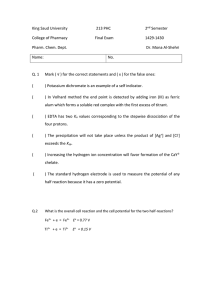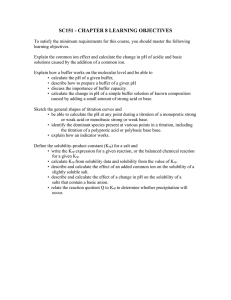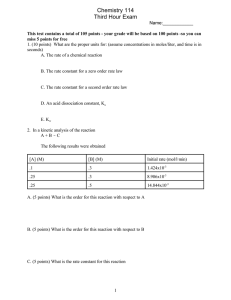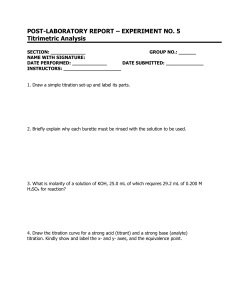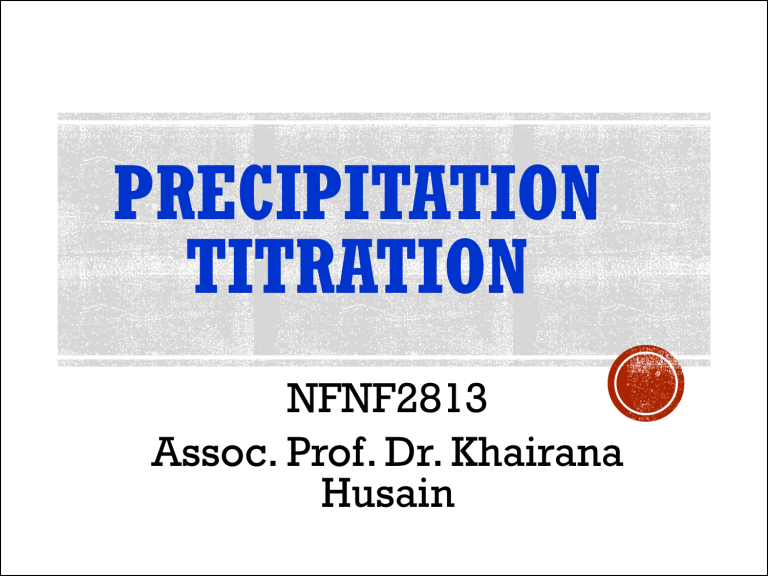
PRECIPITATION TITRATION NFNF2813 Assoc. Prof. Dr. Khairana Husain INTRODUCTION Quantitative Classical Chemical Analysis Acid-base Gravimetry Titrations Precipitation Complexometric Argentometric Mohr Kolthoff Mercurimetric Volhard Redox Fajans INTRODUCTION Precipitation reaction ▪Results in the formation of an insoluble product or precipitate ▪Usually involve 2 ionic compounds react to produce a precipitate EXAMPLE: Pb(NO3)2 (aq) + 2NaI(aq) PbI2(s) + 2NaNO3(aq) These reactions occur when the solute-solute attractions between the ions in the precipitate are stronger than the solvent-solute attractions. Precipitate: ▪An insoluble solid compound formed during a chemical reaction in solution An insoluble substance which falls out of the solution Solubility ▪The maximum amount of solute that will dissolve in a given quantity of solvent at specific temperature PRECIPITATION EQUILIBRIA Consider the general reaction: AgCl (s) AgCl (aq) Ag+ + Cl- Ksp = [Ag+][Cl-] Ksp : solubility product constant , or solubility product [ ] : molar concentration of ion product PRECIPITATION: WILL IT OCCUR? AgCl (s) Ag+ + Cl- To determine whether a precipitate will form→ compare Q and Ksp Q →ion product (original concentrations are used) Q= [Ag+][Cl-] PRECIPITATION: WILL IT OCCUR? If : Q > Ksp : Supersaturated solution; AgCl will precipitate out Q < Ksp : Unsaturated solution Q = Ksp : saturated solution Q= [Ag+][Cl-] Example Write the solubility product expressions : PbI2(s) (b) Pb3(AsO4)2 (s) (a) EXAMPLE What are the molar concentration of Ag+ and CrO42- in a saturated solution of Ag2CrO4 at 25 C? (For Ag2CrO4, Ksp= 1.9 x 10-12). EXAMPLE The Ksp value for copper(II) iodate, Cu(IO3)2, is 1.4 x 10-7 at 25 C. Calculate its solubility at 25 C. SOLUBILITY PRODUCT CONSTANT Solubility product of compound product of the molar concentrations of the constituent ions, each raised to the power of its stoichiometric coefficient in the equilibrium equation. FACTORS INFLUENCING THE SOLUBILITY 1. 2. 3. 4. 5. complexation acidity common ion temperature Solvent properties PRECIPITATION TITRATION (PRECIPITATOMETRIC) ▪ Titrations between analytes and reagents resulting in the formation of a precipitate. ➢ Or which is based on reactions that yield ionic compounds of limited solubility ▪ It is one of the oldest analytical techniques. ▪ The most useful of these precipitating reagents is silver nitrate. PRECIPITATION TITRATION • Used for the determination of many anions including: ➢ ➢ ➢ ➢ halides (most popular) divalent anions mercaptans certain fatty acids PRECIPITATION TITRATION • Precipitation titrations are based SOLUBILITY PRODUCT of the salt, KSP. on the • The smaller KSP, the less soluble the silver salt and the easier it is to determine the endpoint • Endpoint determination is by coloured indicators (usually back titrations) or turbidity methods. The most accurate is the VOLHARD METHOD. TITRATION CURVES A plot of the progress of a titration as a function of the volume of titrant added. OR ▪ a result of plotting postequivalence point region p[X] (p[X]=-log [X]) versus the concentration equivalence point of the titrant ▪ • preequivalence-point region Shape: Sigmoidal curve PRECIPITATION TITRATION CURVES INVOLVING SILVER ION ▪ The most common method of determining the halide ion concentration of aqueous solution is titration with a standard solution of silver nitrate. ▪ To construct titration curve three type of calculation are required, each of which corresponds to a distinct stage in the reaction: (1)pre-equivalence, (2)equivalence, and (3)post-equivalence. PRECIPITATION TITRATION CURVES INVOLVING SILVER ION Titration curves for 100 mL 0.1 M chloride solution versus 0.1 M standard solution of AgNO3 (argentometric methods). Prepared by plotting pCl- (-log [Cl-]) against the volume of AgNO3 NaCl + AgNO3 → AgCl Ag+ + + NaNO3 Cl- x = I-, Br -, Cl- (a) pre/Behind (Beginning) Equivalence Point Of The Titration: ▪ We have 0.1 M Cl-, and pCl is 1 ▪ Titration continues, part of the Cl- is removed from solution by precipitation as AgCl. pCl is determined by the concentration of the remaining Cl-. The contribution of Cl- from dissocciation of precipatate is negligible (coz very small) AgCl Ag+ + Cl- (b) Equivalence Point ▪A saturated solution of AgCl will formed Ksp = [Ag+][Cl-] Notice that : [Ag+]= [Cl-]= x Ksp = [Cl-] [Cl-] = [Cl-]2 Ksp = [Cl-] (c) Post/Beyond The Equivalence Point ▪Excess Ag+ the Cl- concentration is determined from the concentration of Ag+ and Ksp of AgCl. FACTORS INVOLVE IN TITRATION CURVES (1) Solubility ▪ The smaller Ksp, the larger the break pX at the equivalence point (X: Cl-, Br -, I-) Example Ksp value of : AgCl 1 x 10-10 AgBr 4 x 10-13 AgI 1 x 10-16 (1) SOLUBILITY ▪ at equivalence point, [X-] is smaller for the smaller Ksp values. pX is larger for a saturated solution of the salt (AgX). Cont. [X ] = Ksp pX = -log [X ] Cont. (1) SOLUBILITY ▪Beyond the equivalence point, [X ] is smaller when Ksp is smaller. ▪Overall effect: is a larger pX at the equivalence point (2) CONCENTRATION ▪Concentration of analyte and titrant will involve in magnitude of pAg at equivalence point area ▪If concentration of analyte and titrant that have been used more dilute, resulting in smaller pAg at the equivalence point To choice indicator : more difficult. PRECIPITATOMETRIC TITRATION Three types: (1) Argentometric • Involve with silver ion (2) Mercurimetric Hg2+ + 2Cl- HgCl2 (as for other halides) (3) Kolthoff 2 K4Fe(CN)6 + 3Zn2 K2Zn3[Fe(CN)6]2 + 6K+ ARGENTOMETRIC TITRATION ▪ most usefull method of precipitatometric titration, as it caused of very low solubility product of halide (or pseudohalide) salts,i.e. Ksp AgCl = 1.82 x 10-10 Ksp AgCN = 2.2 x10-16 Ksp AgCNS = 1.1 x 10-12 Ksp AgI = 8.3 x10-17 Ksp AgBr = 5.0 x10-18 ARGENTOMETRIC TITRATION • Titrations involving silver or Argentum. • The major precipitation reaction used is that of silver with a range of anions including: ➢ Halides (Cl-, Br-, I-) ➢ Pseudohalides (S2-, HS-, CN-, SCN-) • The reaction rates for the silver salt precipitation is rapid. • The reaction ratio is 1:1 and silver salts formed are generally quite insoluble. Indicators for Argentometric Titrations ❑Three types of end points are encountered in titrations with silver nitrate (1) chemical (coloured indicators) (2)potentiometric (electrochemical techniques) (3)amperometric ❑ The end point produced by a chemical indicator consists of a color change or occasionally, The requirements for an indicator are the color change should : (1)occur over a limited range in p- function of the reagent or the analyte . (2)take place within the step portion of the titration curve for the analyte. DETECTION OF THE END POINT: INDICATORS Three chemical techniques of end point determination: (1) Mohr (indicator : chromic potassium) (2) Volhard (indicator : ferric salt) (3) Fajans (indicator : fluorosceince) (1) MOHR METHOD ▪ Introduced by : K.F. Mohr (Germany/ 1865) ▪ useful for determining Cl- in neutral or unbuffered solutions such as drinking water. ▪ This direct method uses potassium chromate (chromate ions (CrO4 2-) ) as an indicator in the titration of (Cl-, Br-, and CN- )ions (analyte) with a silver nitrate standard solution (titrant). ▪ Eg: Chloride is titrated with standard AgNO3 solution. titration reaction: Ag+ + ClAgCl(s) white precipitate Ksp = 1.8 x 10–10 (1)MOHR METHOD ▪ A soluble chromate salt(Na2CrO4) is added as the indicator. This produces a yellow color solution. ▪ When the precipitation of the chloride is complete, the first excess of Ag+ reacts with the indicator to precipitate red silver chromate, Ag2CrO4(s) Indicator reaction: 2 Ag+(aq) + CrO42–(aq) →Ag2CrO4(s) excess Yellow red ppt Ksp = 1.2 x 10–12 Conditions For Mohr’s Method ▪ The titrations are performed only in neutral or slightly basic (pH 8) medium to prevent silver hydroxide formation (1) at pH > 10 (2) Or the formation of chromic acid at pH < 7. • Reducing [CrO4 2- ] will delay the formation of the precipitate although more Ag+ to be added to reach end point, which cause error. (2) VOLHARD TITRATION ▪ Introduced by : Jacob Volhard (Germany/ 1874) ▪ indirect (back titration) technique which is used if reaction is too slow or if there is no appropriate indicator selected for determining the equivalent point. ▪ Used for determining anions that precipitate with silver (Cl-, Br-, I-, SCN-) in acid medium. ▪ performed in HNO3 solution (acidic solution) to prevent precipitation of iron (III) as the hydrated oxide (2) VOLHARD TITRATION ▪ Ag+ is titrated with standard SCN- solution (in HNO3 solution) while Fe3+ used as indicator Ag+(aq) + Cl–(aq) → AgCl(s) + excess Ag+ ▪ the excess silver ion is determined by back-titration with a standard potassium thiocyanate solution excess Ag+(aq) + SCN–(aq) → AgSCN(s) (2) VOLHARD TITRATION ▪ The endpoint is detected by adding iron III (Fe3+) as ferric ammonium sulfate which forms a soluble red complex with the first excess of titrant. Fe3+(aq) + SCN–(aq) → [FeSCN]2+(aq) (red) (3) FAJAN’S METHOD ▪Used adsorption indicator: an organic compound that tends to be adsorbed onto the surface of the solid in a precipitation titration. Ideally, the adsorption occurs near the equivalence point and results not only in a color change but also in a transfer of color from the solution to the solid (or the reverse). (3) FAJAN’S METHOD ▪ uses an adsorption indicator: Fluorescein, Dichlorofluorescein or Eosin. ▪ The indicator adsorb onto the surface of the silver salt precipitate at the endpoint. ▪ The adsorption process causes a change in the color of the indicator. ▪ Common Fajans adsorption indicators are weakly acidic organic compounds and in alkaline conditions will exist as the conjugate base. ▪ This form of the indicator which interacts with the precipitate (3) FAJAN’S METHOD Indicators have different colour in the free and absorbed form. Changes from greenish yellow to pink Sharper color transition, binds to tightly to Cl- (3) FAJAN’S METHOD ▪ Fluorescein: a typical adsorption indicator useful for titration of chloride ion with silver nitrate. ▪ In aqueous solution, fluorescein partially dissociates into hydronium ions and negatively charged fluoresceinate ion that are yellow-green. ▪ The fluoresceinate ion forms an intensely red silver salt. Example : Fluoresence in form of its fluorescenate (yellowish green) anion react with Ag+ to form an intensive red precipitate which is adsorbed to AgCl precipitate surface caused by ionic pair interaction. Fluoroscein Cl- with Ag+ Dichlorofluorosce Cl- with Ag+ in Eoscein Br-, I-, SCN- with Ag+ Bromophenol Hg2+ with Clblue Orthocrom T Pb2+ with CrO42- EXAMPLE The titration of Cl- with Ag+ as titrant: Na+ Cl- + Ag+ AgCl + Na+ (a) Before the equivalence point ▪ Cl- is in excess, and the primary adsorbed layer is AgCl will be precipitate. AgCl : Cl 1 layer ▪ The primary adsorbed (Cl-) will now attract the cations (Na+) to form secondary layer of adsorbed ions AgCl:Cl-::Na+ 2 layer/counter ion layer ▪ Indicator gives yellow-green colour to solution (b) Postequivalence point region ▪ Ag+ is in excess, the surface of the precipitate becomes positively charged, with the 1 layer being Ag+ ▪ This will now attract the indicator anion and adsorb it in the 2 layer (Indicator is adsorbed on surface of ppt) AgCl: Ag+::In 1 2 BRITISH PHARMACOPEIA 0.1M Silver Nitrate Dissolve 17.0 g of silver nitrate R in water R and dilute to 1000.0 mL with the same solvent. Standardisation. Dissolve 50 mg of sodium chloride RV in water R, add 5 mL of dilute nitric acid R and dilute to 50 mL with water R. Titrate with the silver nitrate solution, determining the end-point potentiometrically (2.2.20). 1 mL of 0.1 M silver nitrate is equivalent to 5.844 mg of NaCl. Storage: protected from light. BRITISH PHARMACOPEIA Silver Nitrate Solution, Ammoniacal Dissolve 2.5 g of silver nitrate R in 80 mL of water R and add dilute ammonia R1 dropwise until the precipitate has dissolved. Dilute to 100 mL with water R. Prepare immediately before use BRITISH PHARMACOPEIA 0.1M Ammonium Thiocyanate Dissolve 7.612 g of ammonium thiocyanate R in water R and dilute to 1000.0 mL with the same solvent. Standardisation. To 20.0 mL of 0.1 M silver nitrate add 25 mL of water R, 2 mL of dilute nitric acid R and 2 mL of ferric ammonium sulfate solution R2. Titrate with the ammonium thiocyanate solution until a reddish-yellow colour is obtained.
